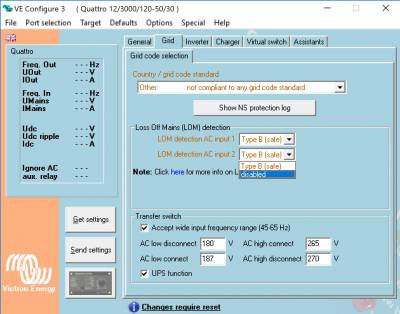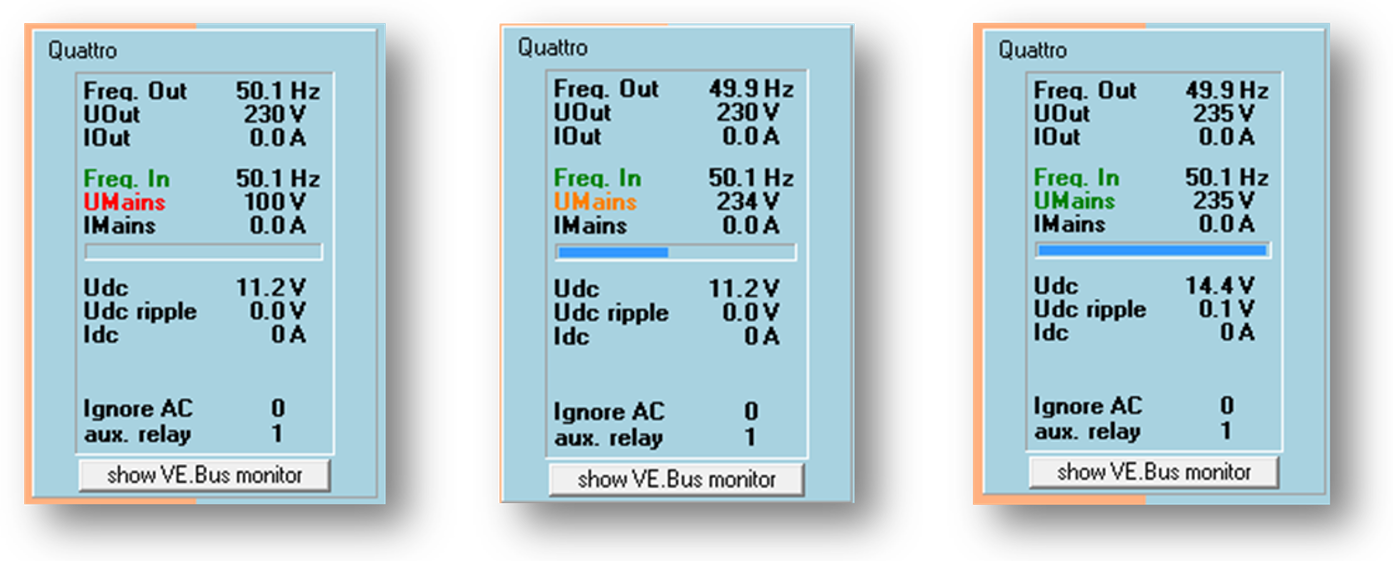Table of Contents
MultiPlus Generator FAQ
What to do when a MultiPlus, or Quattro, does not accept generator power
Power supply from a generator is typically more variable than a power supply from shore or the main grid. The MultiPlus is sensitive to this and will reject power that is outside of it's programmed settings causing the unit to not connect, synchronise or charge.
Selecting a Generator
Some generators are more suitable than others for use with inverter/chargers, please talk to your local Victron Dealer before purchasing a generator and they may be able to advise you on locally available units that have been tested and are known to be good. It is recommended to get a generator from a supplier that is local to you for issues and servicing.
For example; some things to look for when selecting a generator is a high quality alternator and AVR (auto voltage regulation).
AVR equipped generators will audibly struggle and eventually stall when overloaded, signalling there is an issue. They are also better able to cope with a brief high current load which would overload an inverter based generator.
Inverter based generators have a characteristic where the motor continues to run even if the unit has electronically overloaded and no longer delivering power. It may appear that the generator is operating and the system is charging when it isn't. These units are also more easily overloaded by surge loads, as they are electronically limited rather than mechanically.
Make sure that the generator, inverter/charger and regional area frequency and voltage all match. Eg 230V / 50hz. Do not mix and match frequencies and voltages, or parts from different regions.
Generator Sizing
It is possible to overload generators with the power demanded by the Multi's charger. The following generator sizings are indicative of those sizes are appropriate for the charging potential of the various multis. It is still possible to overload these generator sizings with large loads, and flat batteries using the PowerAssist function, so they should be treated as safe minimums to eliminate this as a potential cause of issues. A bigger generator is usually better.
| Inverter Charger Size | Minimum Recommended Generator Size | 240V AC Input Current Limit |
|---|---|---|
| 800VA | 2 kVa | 5A |
| 1200VA | 2.5 kVa | 7A |
| 1600VA | 3 kVa | 10A |
| 3000VA | 5 kVa | 16A |
| 5000VA | 8 kVa | 25A |
If your generator is smaller than the recommended size for your inverter/charger, you will definitely need to adjust the settings on the inverter/charger and reduce the AC input current limit, and/or a DC charge current limit to prevent overloading the generator.
If you do want an inverter based generator (eg for noise reasons under lower loading), get one that is at least 30% larger than required than an equivalent AVR based model to help prevent nuisance overloads.
It is also important to look at the DUTY CYCLE rating of the generator. Some generators are marketed for their peak output, but may only be designed to sustain 50% of that peak load rating for longer periods of time.
Battery charging is a very heavy use case load for a generator, so make sure it is up to the job, and the installation has plenty of good airflow and ventilation when operating to allow for heat to dissipate.
Some generators are only designed to operate for several hours, before requiring time to rest and cool down. Make sure this limitation is part of your load profile and system design.
Operation
It is important to note that the inverter/charger may take a minute or more to synchronise (though it can be much quicker). Treat the equipment with patience if the settings are thought to be correct.
Some generators will alter their voltage or frequency when loads change. This can be significant if the generator goes from no-load to full-load quickly. It can help to have a small 'stabilising' resistive load such as a 75W light globe smooth out this start up voltage/frequency variation.
If the generator is operating smoothly, but it still will not charge the system you may need to make some adjustments in the MultiPlus software via VEConfigure.
Software Settings
The settings which you should attempt first are 'Disable UPS mode' and 'Enable Dynamic Current limiting'. These compromise features, but maintain the quality of the power supply.
If the generator will still not synchronise or disconnects, try turning on the setting for Weak AC. This will compromise efficiency, but allow for a wider variation in wave form distortion to be accepted.
Lastly, adjusting the settings for Voltage and Frequency windows. These are higher risk to your appliances, they should only be used cautiously when it is confirmed that the loads will tolerate the out of specification power supply. This should be done by a competent technician with the aid of a multimeter and only opened so far as to allow for safe functionality.
Electrical current will go through the MultiPlus only if it meets the programmed minimal quality requirements; in that way the MultiPlus protects the electrical supply of delicate equipment.
Warning: changing these settings will allow to feed-through current that may be of insufficient quality for the electrical requirements of your equipment.
For information on VEConfigure and how to get started, please see this VE Configure Software page, or contact your local Victron dealer.
1. In the “Grid” tab of VEConfigure:
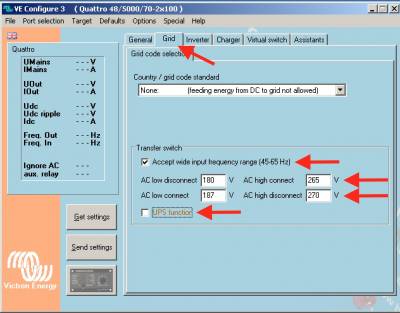
1.1 Wave shape quality
UPS Function: (default = enabled)
When the sine wave is of good quality, the Inverter of the MultiPlus will hook up on it, thus allowing a synchronised and fast transfer when the generator stops.
Many generators have more or less ill-shaped sine waves, in particular during sudden load changes. In these situations, the MultiPlus will disconnect frequently or not connect at all. The UPS function must then be deactivated. The drawback is a slightly longer transfer time.
1.2 Frequency stability
Accept wide input frequency range (45-65Hz): The MultiPlus accepts frequencies from 45 to 65Hz (default = enabled). If the generator is extremely stable and if that same stability is required on the output of the MultiPlus, this setting may be disabled.
1.3 Minimum voltage levels
AC low disconnect: low limit: below this value, the MultiPlus will disconnect (default = 180Vac).
On generators where the output voltage drops under load, setting this value to a higher value can help resolve inverter overload shutdowns.
The reason this happens is that the Multi will synchronise and follow the generator voltage as it sags.
If the generator is disconnected under load (either due to low-voltage disconnection, stalling, lack of fuel, etc) then when the Multi switches back to inverter mode; it must immediately supply all the power required by the loads at that same low voltage (and subsequent higher current).
As overload is driven by current, not power, this can result in an overload.
By increasing this minimum voltage level, you tell the inverter/charger switch to inverter mode sooner, at higher voltage and thus lower AC current, and potentially prevent the overload from occurring.
AC Low connect: minimum value: at this value or any higher value, the MultiPlus will reconnect after having disconnected (default = 187Vac).
1.4 Maximum voltage levels
AC high disconnect: high limit: above this value, the MultiPlus will disconnect (default = 270Vac).
AC high connect: maximum value: at this value or any lower value, the MultiPlus will reconnect after having disconnected (default = 265Vac).
1.5 Loss of mains detection (LOM) (Only applicable to ESS systems)
This part is only applicable on systems where a grid-code is selected (generally only ESS systems) on an off-grid system a grid code should not be used and in the selection box for grid code, 'none' should be selected.
Loss of mains detection will push and pull at voltage and frequency to see if there is still a generating source. This process can cause issues with some generators, or high impedance connections to generators.
For large and stable Generators Type B LOM will work, and is safer. However, if you are experiencing issues with voltage, frequency or power fluctuations, you may wish to try Disabling LOM.
Disabling LOM
Disabling the LOM on an input connected to the grid is only allowed when other external safety equipment is installed. Disabling the LOM on an input connected to generator can be done, but then other methods / warning signs / physical lockout safety measures must be provided. Ensuring that any installer that will work on the generator, wiring or system, will make sure to also switch off or otherwise disconnect the Inverter/charger system.
For Full information on Loss of Mains detection, please see this more detailed explanation.
Example configuration in VEConfigure
- A generator that requires LOM to be disabled.
- Generator on AC in 1, and grid on AC in 2, as recommended.
2. In the “General” tab of VEConfigure:
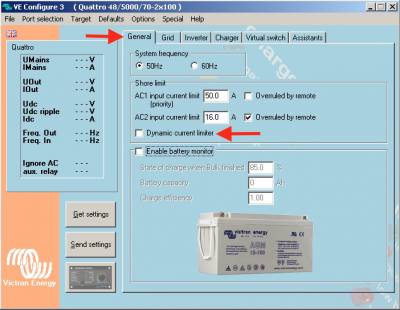
2.1 Dynamic current limiter
(default = disabled)
This feature is intended to reduce load impacts on low-power generators, such as portable inverter technology models. These generators may be unable to respond to sudden load impacts.
By activating the limiter, the PowerAssist® function of the MultiPlus will absorb the change in load and transfer it smoothly to the generator, giving it time to react.
2.2 AC Input Current Limit
The charger on the Multiplus is very powerful. If you have an existing generator that is not able to supply the maximum charging current of the Multi, you will need to adjust the AC Input Current Limit in the General Tab of VEConfigure.
A reasonable starting point for the AC Current input limit is 80% of the generator capacity in Watts. For example:
a 5kVA generator typically provides about 4 kW
80% of 4 kW is 3200 W
3200 W / 230 V volts = 13.9 A
Set the AC Current Input Limit to 13 A
If you find the generator is still overloading, or running too hard, you may lower this further. It can also be increased if you find the generator easily handles the load (though this can be difficult to test as it requires a flat battery to maximise charging demand and a large load).
There is another additional setting in the Charger Tab for DC current limiting.
The AC input current should be adjusted first, as it also takes into account the PowerAssist functionality.
The Multi is able to synchronise the generator waveform with it's own and provide power to the loads from the generator as well charging the battery. This means it still possible to overload the generator with a low 'DC Charger current limit' if the AC input limit is not also set correctly to the size of the generators output.
3. In the "Charger" tab of VEConfigure:
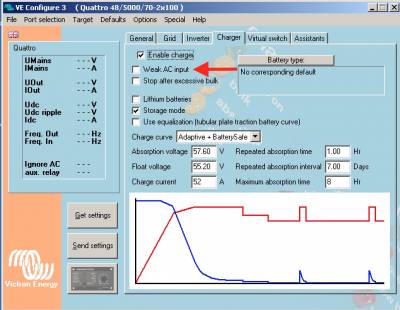
3.1 Derating of the power factor
Some generators have a waveform which makes it difficult to charge with the normal charge mechanism. Through activating the “Weak AC input” function, another mechanism is used which will enable the MultiPlus to charge under practically any condition.
Disadvantage of using this option is that the input power factor, normally equal or close to 1, will be degraded. This function should be used only when the preceding ones are ineffective.
This leading or lagging power factor will have the effect of demanding more kVa from the generator for the same or less DC Watts delivered to the batteries. You may need to further reduce the DC Current Limit in the Charger tab of VEConfigure if the generator continues to overload after changing this setting.
Effectively, when Weak AC is enabled, the total charge current possible will be less that the rated maximum charge current output of the charger (under normal conditions).
Important note:
A detailed description of all settings is available in the VEConfigure help menu, and more instructions are available in our manuals.
4. In the “Inverter” tab of VEConfigure:
4.1 PowerAssist
The PowerAssist feature can be extremely useful, however it restricts the minimum AC input current limit and this may exceed your generators ability to supply. The exact restriction varies between models - see here for the list.
If you have a small generator and have trouble getting connected or staying connected, Disable PowerAssist to allow the device to reduce the AC input current limit.
There is an additional configurable parameter of PowerAssist called “Boost factor”
When the Multi is charging from the generator, and the current required exceeds the AC input current limit (due to a sudden additional load) then the Multi will switch to PowerAssist mode.
At that moment the precise current needed is unknown. The Multi uses the “Assist current boost factor” setting as a multiple of the AC input current limit, and attempts to provide that much additional current.
In some cases this multiple is either too high, or too low. This would most likely present as the generator unable to stay connected, or fluctuations to the frequency and voltage.
The fastest way to diagnose if setting may be interfering with your specific generator and load operation is to disable power assist entirely. If that resolves the issue, then try reducing the Assist current boost factor down until it works reliably and still getting the benefit of the feature without the interference. The optimal value for this will depend on the size of the inverter, the size of the generator, and the size of the load.
For more information about how this Boost factor behaves, see the explanation by Johannes Boonstra here.
5. Generator control in 3 phase and parallel systems
There is some specific and non-intuitive conditions when setting AC input current limits, and Charge Current limits for Large systems that involve more than one MultiPlus, and/or a GX device.
Those specific details are articulated here: https://www.victronenergy.com/live/ve.bus:manual_parallel_and_three_phase_systems#configuration
Described in the online training theory here: @ 38 minutes and 43 seconds - https://professional.victronenergy.com/online-training/20/
Demonstrated in the 3 phase installation training here: @ 25 minutes - https://professional.victronenergy.com/online-training/21/
Still not connecting?
If the unit is still not connecting,
Check the VE.Bus Monitor and AC Input Connection timer
With Multi firmwares xxyy460 and up, VEConfig will indicate why the AC Input is rejected and will also show an indication of the remaining waiting time as a blue bar.
After the waiting time the unit will connect to AC input provided that there is no assistant which prevents the unit from connecting to grid and that the required relay test is performed.
Switch the Multi over to Charger only mode.
Try with a different generator.
As troubleshooting and correcting these faults have serious safety implications, they are best discussed with a local installer who has appropriate electrical qualifications, or your Victron Dealer.
There can be issues with generators with Residual Current Devices (RCD's), control electronics or circuit breakers. There is some discussion about troubleshooting these issues on this Victron Community Question - Multiplus With Generator And Residual Current Device.
Simplify the AC wiring, With everything safely shut down and tested for voltage, disconnect the AC-Output active, neutral and earth. Direct wire in the generator connections, with no other bus bar links. A common neutral can cause issues.
If there is still no connection, contact your dealer or distributor. Tell them the steps that you have taken already to attempt to get it to work and they can help from there.
Further Reading
There have been extensive articles and documentation written about generators and their interaction with Victron systems. This includes troubleshooting, real-world application and theory.
MultiPlus magic: Small generator, big power - In depth blog article with a real world application of a sailing yacht.
Using the Multiplus to reduce operating cost of a generator - Fuel Saving White-paper.
Marine Generator Test - Detailed testing and the application of marine diesel powered generators in small hybrid power systems
Automatic Generator start/stop - Outline and reference for generator auto-start functionality in Victron systems.
Victron Community Questions and Answers about generators.
Victron Inverter/Chargers and Honda Generators
MultiPlus & Quattro Inverter/Chargers: Minimum AC Input Current Limits
 Add this page to your book
Add this page to your book  Remove this page from your book
Remove this page from your book  Manage book (
Manage book ( Help
Help 